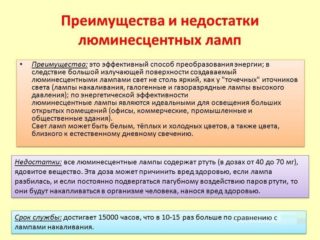Luminescent light sources have taken their place in the field of illumination of houses, apartments and non-residential premises. Even despite the emergence of modern LED lamps, gas-discharge devices are actively used. This is primarily due to energy savings, since luminescent devices are energy-saving. One of the most popular varieties is the 36 W fluorescent lamp. It differs from other devices in its characteristics and technical features.
Design features and principle of operation
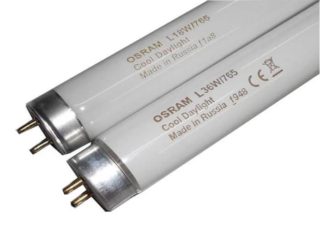
The 36 W lamp is a conventional glass tube, the ends of which are sealed. The inside of the flask is treated with a special agent - a phosphor, which converts the received ultraviolet radiation into visible light. The tube is also filled with a mixture of argon and mercury gases. All the air is first pumped out of the pipe. The current flows through a tungsten coil, which is coated with oxides to increase reliability. Nickel electrodes are connected to the ends of the spiral.
For the light to light up, you need to apply an electric current. It raises the temperature of the coil, which causes a discharge. The resulting ultraviolet light passes through the phosphor and the walls of the flask and turns into visible radiation at the exit.
Inside the flask is a mixture of different gases and vapors, which is a plasma. It emits a stream of light in the visible and invisible spectrum. The phosphor converts invisible radiation into visible light, and as a result, the lamp can illuminate a specific area.
Thanks to this design and improved materials, the light bulb will consume less energy than conventional lamps. Compared to an incandescent lamp, the amount of energy required will decrease several times.

Types of fluorescent lamps
Any fluorescent devices can be divided into two groups:
- General purpose lamps. These include luminaires with a power of 15 to 80 watts.
- Special purpose. These are devices up to 15 W and over 80 W. They are called low-power and super-power, respectively.
General purpose lamps provide natural light.
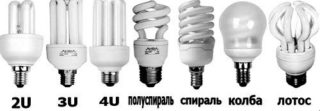
Also, devices can be divided according to a number of technical indicators:
- By light discharge: arc and glow.
- By radiation: with natural light, ultraviolet and different colors.
- By the shape of the flask: linear tubes and curly models.
- Along the length of the tube.
- By the base used: 14 mm and 27 mm.
- By distribution of light flux: directional and non-directional.
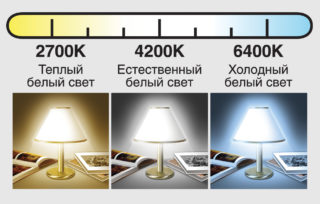
Color temperature classification:
- 2700-3400 K. These are warm shades. They have a calming and relaxing effect, therefore they are often placed in bedrooms.
- 3400-5600 K. Natural radiation is produced. Applicable in living rooms, kitchens and other types of premises.
- 5600-6400 K. Cold tones. They increase tone and efficiency, therefore they are used in offices.
A 36 W fluorescent source is analogous to a 40 W device. This is due to the fact that modern technologies make it possible to use better, more reliable and modern materials.
Energy-saving devices use a high-quality phosphor layer and an improved design of the electrode block.Thanks to all these features, fluorescent bulbs with a lower power have a higher luminous effective flux. It is also important to note the decrease in the diameter of the tube by 1.6 times.
Light source marking
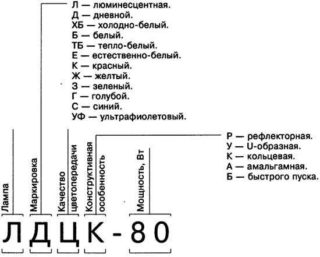
The 36 W fluorescent lamp has a simple letter and number marking. For example, a 36w fluorescent lamp with the abbreviation LB-36 stands for the following:
- L - lamp.
- B - white.
- 36 - power, W.
There are also 36W fluorescent lamps with different markings:
- LTB. Warm white light. They have a subtle pink tint.
- LD. Close to daylight.
- ЛДЦ - fluorescent lamps with different colors.
- LHB is cold white.
The given markings are used in Russian products. The foreign designation is different. It consists of three numbers and English words indicating the type of glow. The marking may differ for different foreign manufacturers.
LU products are the most efficient in terms of the output luminous flux in comparison with other devices of the same power.
Specifications
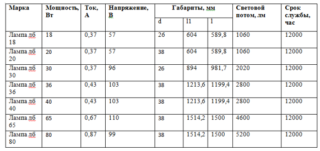
The 36 watt lamp has the following characteristics:
- radiation brightness 6-11 Cd / m2;
- ripple factor 23%;
- brightness and power increase with the growth of the nominal voltage;
- service life from 4800 hours, average value is 12000 hours;
- base G13;
- flask diameter 26 mm;
- the length of the greater part is 12 cm;
- rated voltage 103 V.
The data shown are average values. They may vary from manufacturer to manufacturer and to specific operating conditions. The service life can be significantly reduced due to frequent switching on and off or high humidity in the room and low temperature. Therefore, it is important to choose the right location for the light source.
Advantages and disadvantages
Fluorescent devices are inferior to LEDs, but are still often used for backlighting. This is due to the positive qualities of the 36 W fluorescent light bulb:
- small dimensions and weight;
- wide scope;
- saving;
- large coverage area;
- extended glow spectrum;
- long service life;
- good efficiency;
- availability of analogs for various purposes and colors.
There are also disadvantages to light bulbs:
- the presence of harmful substances in the composition of the device;
- the complexity of disposal;
- harm to human health and eyes;
- choke required to start;
- increase in value;
- long launch;
- reduced service life due to frequent switching on and off.
The devices are actively used and replace outdated incandescent lamps and halogen appliances.
Applications
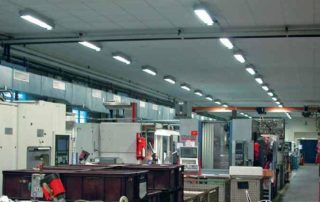
Fluorescent lamps have a wide range of uses. They can create all types of lighting in living quarters, offices, fill production rooms with light, and create illumination.
The devices have also found their application in medicine. Using special fillers, germicidal and ultraviolet lamps can be created. They are used to clean the premises from bacteria and germs. Also, lamps can be installed in shops, warehouses and enterprises for the purpose of disinfecting premises.
The ability to create sources of different colors has led to the use of fluorescent bulbs in entertainment, show business, and advertising.
Selection recommendations
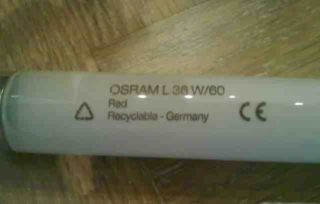
Lamps are selected for a specific type of luminaire. This obliges the buyer to pay attention to its characteristics. Fluorescent lamps should be chosen especially carefully. For example, the Russian LB 36 lamp has a length of 1200 mm and is suitable for installation in an appropriate device. A 35 W device of a similar power from the German company OSRAM has a different length - 1449 mm. The length of the tube must be taken into account when purchasing.
Attention is paid to the diameter of the flask. The standard is 16 mm, but devices for 12 mm, 25 mm and other sizes can be found. The luminous flux directly depends on the diameter.In luminaires, you can use a tube with the same base (G13) with a smaller diameter, but not with a larger one.
Fluorescent lamps have pulsations that are detrimental to health. To reduce the negative impact, you should give preference to quality, expensive and proven devices purchased from a professional store. A lamp of unknown origin is made from low-quality components, and this directly affects the flicker.

